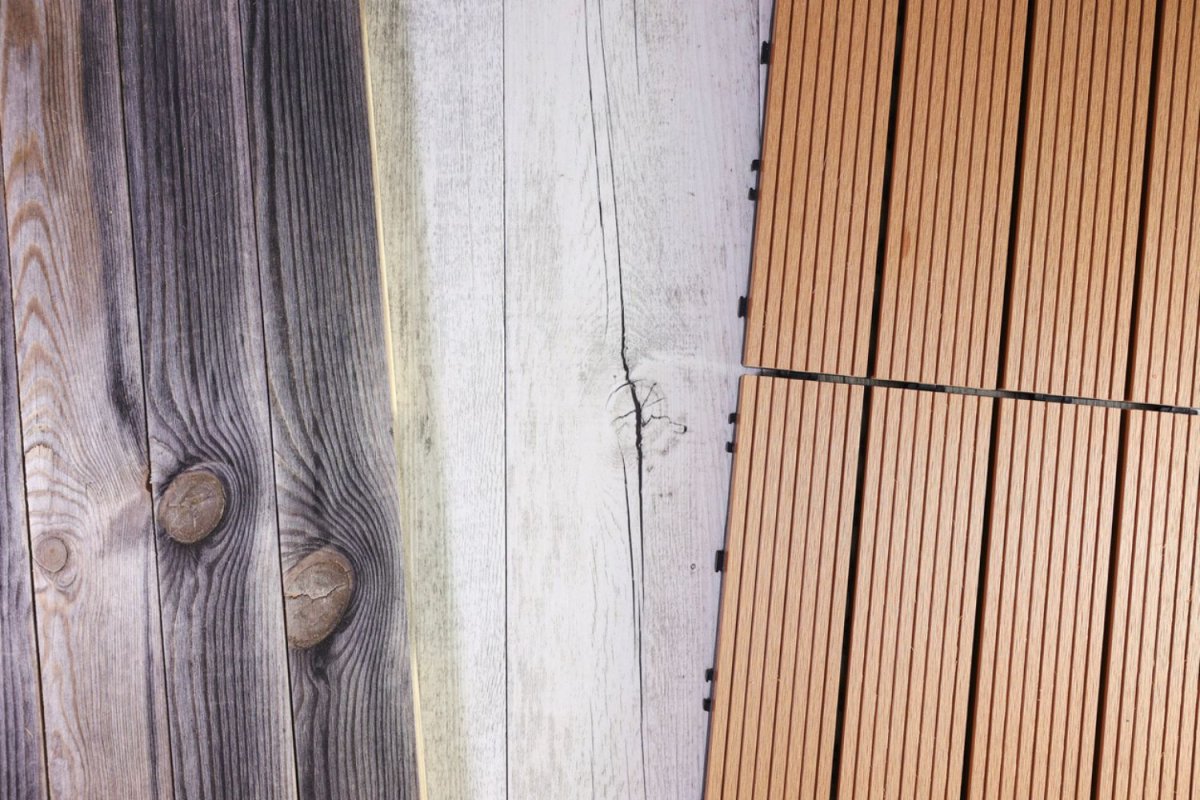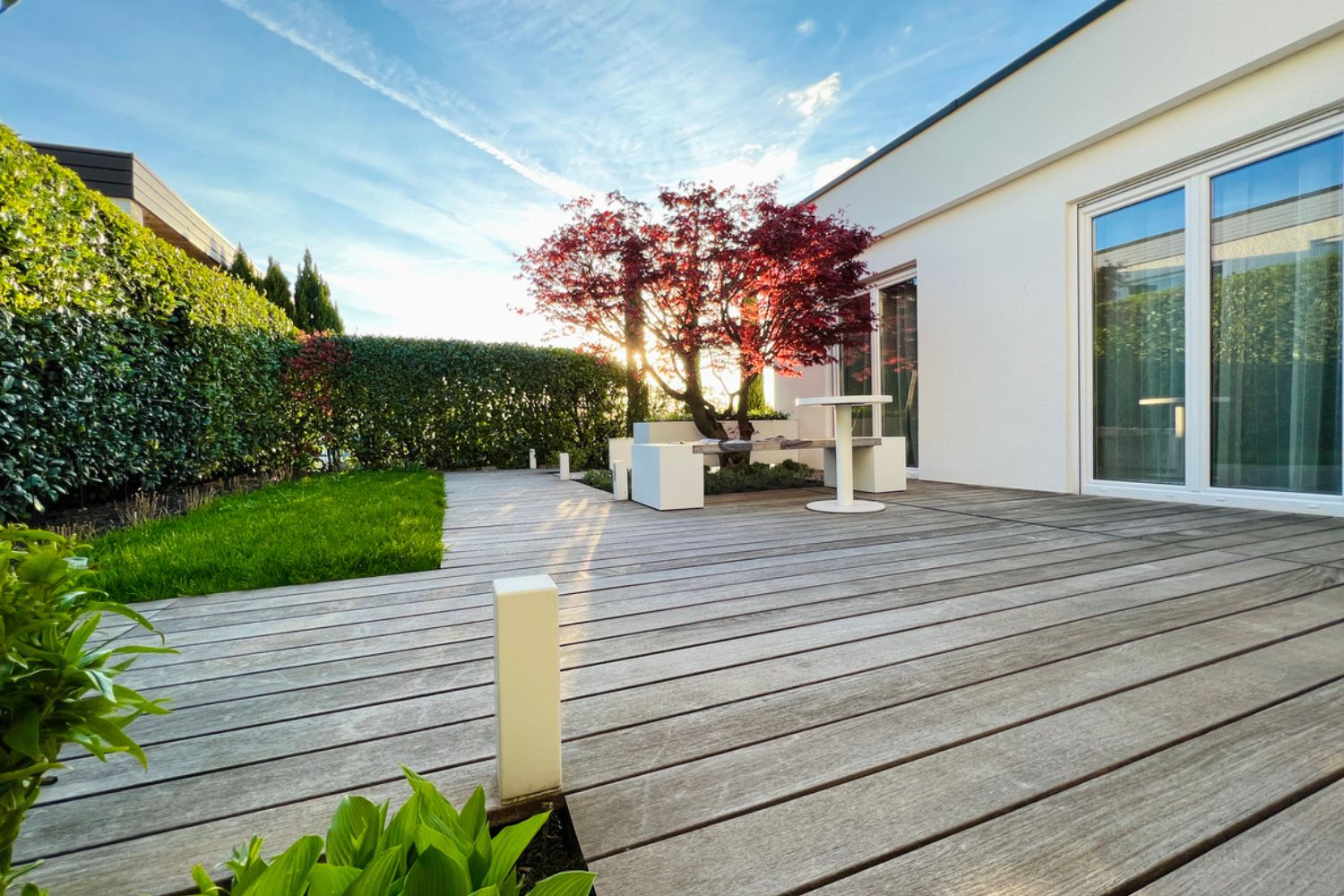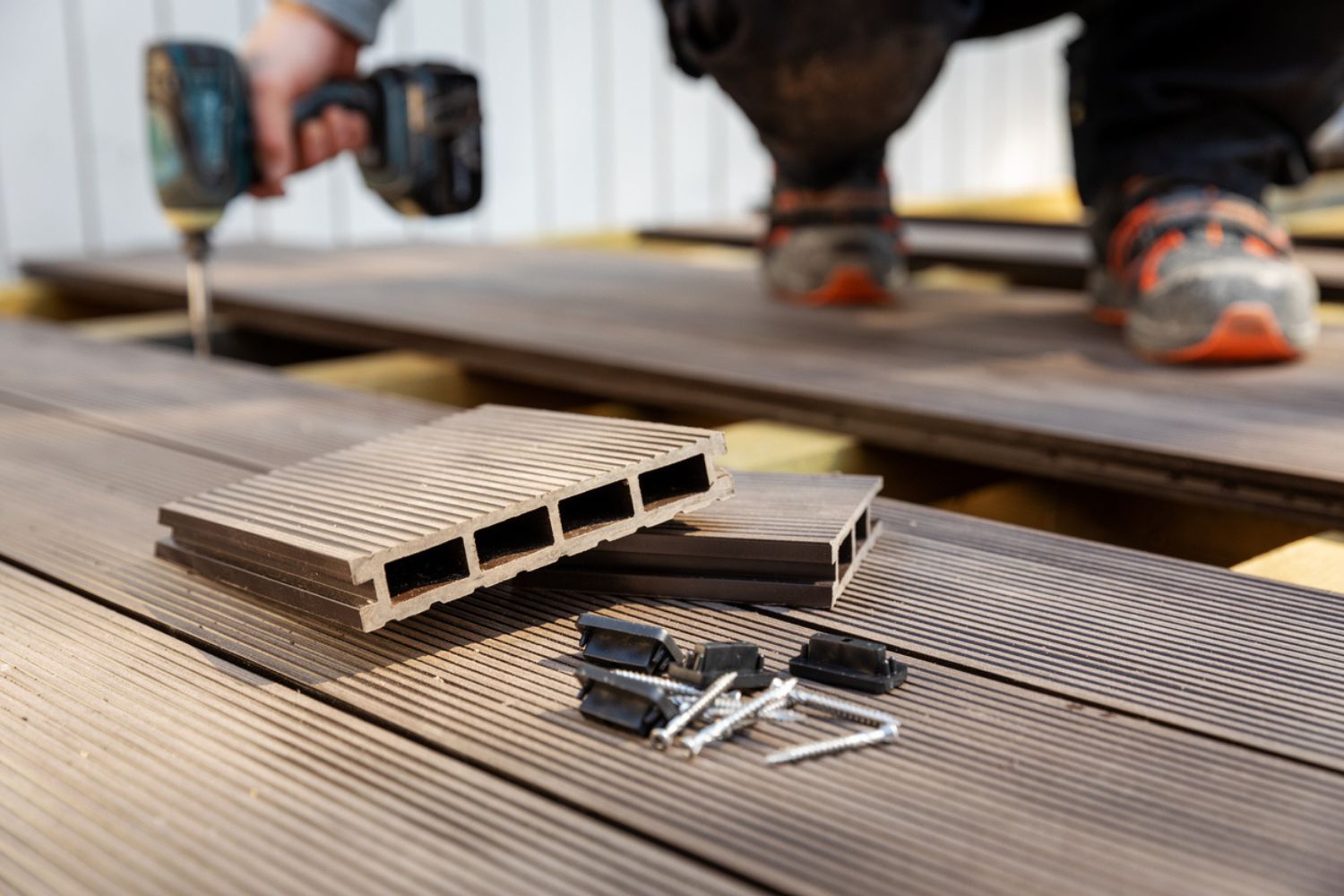

We may earn revenue from the products available on this page and participate in affiliate programs. Learn More ›
Homeowners who are looking to install or replace a deck are typically faced with a major choice: composite decking vs. wood. Both are considered among the best decking materials, though each has its benefits and drawbacks. Some homeowners will base their choice of decking materials on their budget and design style, while others will consider the climate and ease of maintenance. Depending on the type of wood, wood decking is typically less expensive than composite decking material, but it requires more maintenance over time. Composite deck materials are durable, sustainable, and easy to install. Average composite decking prices range from $3,600 to $7,800, with many homeowners spending an average of $5,450. A pressure-treated wood deck can cost between $15 to $25 per square foot, while a cedar wood deck can cost from $4 to $9 per square foot. The overall price of deck boards, whether they’re real wood or composite decking, depends on the brand, local prices, and the individual material or wood species. Aside from choosing the size of the deck and other design considerations, homeowners need to decide on whether to use composite deck boards or wood for their decking project. This guide will examine different decking options, how to estimate decking costs, the difference in pricing for composite decks and wood decks, and the required maintenance for each material.
Composite Decking vs. Wood Decking
Both wood and composite decking material have pros and cons, which include price, lifespan, durability, and level of maintenance. Which type of decking material is the best? Below is a comparison of each material.
- Composite decking. What is composite decking? Composite decking is made from a wood plastic composite (WPC) and is designed to look like real wood boards. Depending on the brand and the quality of the composite material, some boards have a realistic grain pattern, and some brands give buyers a choice between a simpler pattern or grain patterns that don’t repeat. The composite material is composed of natural elements, such as bark, nut hulls, bamboo, and wood pulp mixed with a powder that’s typically formulated from polyethylene or polypropylene plastic. Environmentally conscious homeowners typically choose composite decking material, since it’s made from natural waste material and the boards can be recycled into new materials when the deck has reached the end of its lifespan. The recycled plastic material can be used to make more decking material or other goods. The wood plastic composite can be dyed during production, and composite deck boards are available in a variety of color choices. Trex is a popular composite decking brand, and the company offers a wide selection of colors for its wood-alternative decking material. The cost of Trex decking ranges from $1,600 to $9,600, with the national average at $4,800. Depending on the local costs of lumber, some homeowners may find Trex to be more affordable than lumber, while others will find the opposite to be true.
One of the biggest draws to using composite decking material is that it’s practically maintenance-free. Unlike wood, composite boards do not need to be sanded, stained, or sealed, and the material only requires cleaning twice a year with soapy water and a deck brush or a low-powered washer. The cost to hire a professional to power wash a deck ranges from $90 to $770, with many homeowners spending an average of $150. Composite decking material is durable, stain-resistant, long lasting, and holds up to normal wear and tear for up to 50 years. It is not susceptible to insect damage, and it does not rot or splinter. With built-in UV resistance, composite decking will not fade or lighten as much as natural wood decking. Homeowners who wish to change the look of their composite deck can stain or paint it to keep it looking like new for longer—learning how to stain a wood deck can help homeowners save money on deck maintenance.
High-quality composite decking is usually more expensive than wood at an average cost of $15 to $36 per square foot. Considering that the cost of maintenance for a wood deck can be about $1,000 per year, the up-front costs of installing a composite deck are worth it to many homeowners. One thing for homeowners to consider is that a composite deck needs to be framed with real wood since the natural material is strong enough to hold the weight of the deck and anything on it. The substructure of a composite deck is usually constructed of pressure-treated lumber, although some composite decking material brands recommend a steel substructure to support their material, and it can cost 35 percent more than a pressure-treated one. Lumber costs and the local cost of labor also need to be figured in with the price of the composite material when budgeting for composite deck installation.
- Wood decking. Wood is the classic material choice for a deck. Depending on the type of wood, it can be a budget-friendly option, with yellow pine at the lower end of the price range and wood species such as redwood and cedar coming in at a more moderate price. Imported wood boards, such as Brazilian walnut (also known as ipe), will be considerably more expensive. Natural wood decks need significantly more maintenance than composite ones. Wood decking requires sanding, staining or painting, and sealing about every 2 to 5 years. The cost to stain a deck ranges from $540 to $1,250, with many homeowners spending an average of about $775. If the natural material is left untreated, it is more susceptible to fading, water damage, and rot. Pressure-treated wood is known to warp and splinter from being exposed to the elements. However, with regular maintenance, a wood deck can last 20 years or more.
For homeowners looking to save money on up-front deck installation costs, a wood deck is a budget-friendly option. Pressure-treated lumber can cost from $15 to $25 per square foot, redwood ranges from $4 to $6 per square foot, and the cost of cedar runs from $4 to $9 per square foot.
How to Estimate Decking Costs
When building a new deck, it’s important for homeowners to estimate the overall costs to design a budget. Below are a few steps homeowners will want to take to find out how much a deck will cost.
- Measure the area and determine the style and size of deck that will work the best for the space.
- Mark the area where the deck will be to get an idea of whether the size is correct and if it will work for a your needs. Keep in mind that the size of the deck is a significant factor in determining the overall price of materials and installation cost.
- Consider what types of accessories are optional and what are required for the deck. If some add-ons can be postponed, it can save money and help a homeowner stick to their budget.
- Talk with professional deck builders or local home improvement stores to get a good idea of local labor costs and what they would recommend for decking materials.
Composite Decking Cost vs. Wood Decking Cost
Composite decking tends to cost more up front than wood decking because it is more time-consuming to manufacture. The average cost per square foot for different wood and composite deck materials can be found below in the decking material cost comparison chart.
| Decking Material | Cost per Square Foot (Materials Only) |
| Cedar wood | $4 to $9 |
| Composite | $15 to $36 |
| Pressure-treated wood | $15 to $25 |
| Redwood | $4 to $6 |
1. Composite decking typically has a higher cost than wood decking.
While composite decking is typically more expensive than wood, lumber prices have been volatile in recent years and can change quite frequently. Homeowners will also want to take into consideration the lifespan of decking materials and how that factors into the price. Since composite decking lasts much longer than wood, many homeowners determine that the more expensive up-front cost of composite decking is worth it in comparison to the amount of money they’d spend maintaining a wood deck over the years.
2. There are several types of wood decking materials available, each with different price points.
Pressure-treated wood is strong and provides a traditional look to a deck. It is high maintenance and requires staining or painting every 2 to 5 years. There are limited style and design options with a pressure-treated lumber deck, and exposure to moisture can result in mold and mildew growth, splitting, splintering, and cracking.
Cedar decking has a more luxurious look than pressure-treated wood. It’s durable and longer lasting, but it still requires staining and sealing to make it look like new. Exposure to water also makes this wood more susceptible to cracking, splintering, and mold and mildew growth.
Cedar, redwood, and ipe are graded according to the clarity and quality of the wood. Decking boards with minimal knots, imperfections, or mineral stains receive a higher grade and are more expensive than lower-graded decking boards. Wood boards that are wider than the standard decking board width are also more expensive by the square foot since they’re made from bigger logs, which is less common.

3. The cost of a wood deck hinges on the price of lumber, whereas composite deck pricing tends to be more stable.
The overall cost of installing a wood deck is influenced by the price of lumber. Different types of wood cost different amounts, and these prices can fluctuate because of availability and local demand. Pine is typically the least expensive of decking materials, with cedar and redwood costing more, and popular exotic woods like cumaru (Brazilian chestnut) and ipe as some of the most expensive. The price of composite decking material stays relatively stable compared with the price of wood.
4. Labor costs to install composite decking may be lower than for wood decking since there’s no woodwork or sealing involved.
The average labor cost to install a composite deck ranges from $10 to $14 per square foot, or between $1,500 to $2,000 added to the price of materials. For a wood deck, labor can run from $15 to $35 per square foot. Labor estimates for both composite and wood decks can vary due to a few important factors. Adding railings or stairs to the deck will increase labor costs, as can deck design. Building a rectangular-shaped deck is usually the most budget-friendly option, and complex deck designs and multilevel decks involve more measuring and cutting, so the labor costs will increase. Decks that are built on a slope will require more time and effort, as will building a deck in a location that needs to be cleared of trees, rocks, or other vegetation. Labor rates are also based on the time of year and the demand for deck-building services. Wood decks need to be stained or painted and sealed before they can be enjoyed, which will also increase labor costs. Depending on the type of wood used for a deck, some hardwoods need pilot holes drilled before they can be fastened together, which increases the labor time. Labor rates in densely populated urban areas with a higher cost of living are typically more expensive than in more rural regions of the country.

5. Despite its higher cost, composite decking is durable and resistant to stains and UV damage and requires little or no maintenance.
Unlike natural wood decks, composite decking material will not lighten or fade as quickly and will keep its color for a longer time. Composite material also resists staining and weathering longer than wood, so it stays looking newer for an extended length of time. The only maintenance that’s required for composite decking is washing it twice a year with soapy water and a deck brush or a low-powered pressure washer.
6. Wood decking has a higher long-term cost because it requires regular maintenance, such as sanding, staining, and board replacement, to keep it in good shape.
While the up-front costs of wood decking are more budget-friendly, the maintenance costs can add up over time. About every 2 to 5 years, homeowners will need to sand, stain or paint, and reseal the deck to keep it in good condition. Hiring a professional is more expensive than a DIY deck-maintenance project, but it still costs money and time for homeowners to complete the maintenance on their own. Knowing how to restore a weathered deck and how to waterproof a deck is valuable knowledge for any homeowner to have.
7. Composite decking gets hot in direct sunlight and can be slippery when wet, which may make its higher price harder to justify.
Since composite decking can get very hot in direct sunlight, it can be very uncomfortable to walk on in bare feet. Some homeowners prefer to use outdoor rugs on their composite deck to protect their feet on hot days. When composite decking material gets wet, it can get slippery—especially in shady areas if algae and mold have started to grow. In cold-weather months, treating the area with sand or salt can help provide some traction.

8. Homeowners can refinish a wood deck to restore its luster, but composite can’t be refinished and will need to be replaced instead.
When a wood deck begins to show signs of wear and tear, it can be sanded, stained or painted, and resealed to make it look like new. When a composite deck starts to show its age, it’s not able to be refinished, making replacement the only option. Knowing when to repair or replace a deck is based on the amount of wear and tear, the decking material, and the overall age of the deck.
9. Homeowners with a limited budget may prefer to install a wood deck and attempt DIY maintenance to save money. Those with a higher budget who are looking for a lasting, maintenance-free deck may prefer composite.
Homeowners who don’t mind putting aside a weekend every 2 to 5 years to maintain their deck can save money doing it themselves compared with hiring a professional to do it for them. For some, the look of real wood is one benefit of having a wood deck, and the maintenance to keep a wood deck looking its best just goes along with it. Along with regular maintenance, wood deck repair costs also need to be considered when homeowners are calculating how much installing a wood deck will cost. Those who have a higher budget and don’t want to be bothered with any type of maintenance aside from a quick cleaning twice a year often think the more expensive up-front cost of composite decking is worth it.
Sources: Decks.com, Deck Cost Guide, Decks Direct
